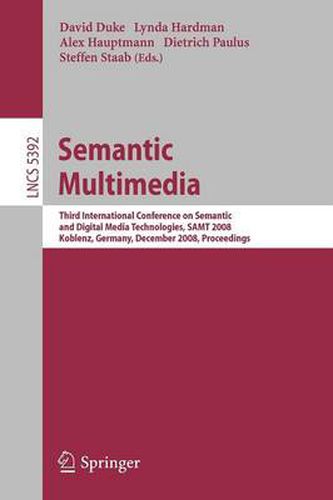Readings Newsletter
Become a Readings Member to make your shopping experience even easier.
Sign in or sign up for free!
You’re not far away from qualifying for FREE standard shipping within Australia
You’ve qualified for FREE standard shipping within Australia
The cart is loading…






This title is printed to order. This book may have been self-published. If so, we cannot guarantee the quality of the content. In the main most books will have gone through the editing process however some may not. We therefore suggest that you be aware of this before ordering this book. If in doubt check either the author or publisher’s details as we are unable to accept any returns unless they are faulty. Please contact us if you have any questions.
WearepleasedtowelcomeyoutotheproceedingsoftheThirdInternationalC- ference onSemantic andDigital Media Technologiesheld inKoblenz,Germany. The SAMT agenda brings together researchers at extreme ends of the - mantic multimedia spectrum. At one end, the Semantic Web and its supporting technologies are becoming established in both the open data environment and within specialist domains, such as corporate intranet search, e-Science (parti- larly life sciences), and cultural heritage. To facilitate the world-wide sharing of media, W3C is developing standard ways of denoting fragments of audio/visual content and of specifying and associating semantics with these. At the other end of the spectrum, media analysis tools continue to grow in sophistication, identifying features that can then be associated with explicit semantics, be they expressed formally or informally, using proprietary formats or open standards. Recent progress at these two fronts of the SAMT spectrum means that research spanningthesemanticgapisnowofvitalimportancetofeedtherealapplications that are emerging. This conference also represents a step towards bridging the gap between the research cultures and their respective approaches at both ends of the spectrum. The papers selected show that SAMT is able to attract researchers from media analysis, who see the bene?ts that more explicit semantics can provide, as well as researchers from knowledge engineering who realize that, while a picture can be expressed as a thousand concepts, a million morearewaiting to be extracted.
$9.00 standard shipping within Australia
FREE standard shipping within Australia for orders over $100.00
Express & International shipping calculated at checkout
This title is printed to order. This book may have been self-published. If so, we cannot guarantee the quality of the content. In the main most books will have gone through the editing process however some may not. We therefore suggest that you be aware of this before ordering this book. If in doubt check either the author or publisher’s details as we are unable to accept any returns unless they are faulty. Please contact us if you have any questions.
WearepleasedtowelcomeyoutotheproceedingsoftheThirdInternationalC- ference onSemantic andDigital Media Technologiesheld inKoblenz,Germany. The SAMT agenda brings together researchers at extreme ends of the - mantic multimedia spectrum. At one end, the Semantic Web and its supporting technologies are becoming established in both the open data environment and within specialist domains, such as corporate intranet search, e-Science (parti- larly life sciences), and cultural heritage. To facilitate the world-wide sharing of media, W3C is developing standard ways of denoting fragments of audio/visual content and of specifying and associating semantics with these. At the other end of the spectrum, media analysis tools continue to grow in sophistication, identifying features that can then be associated with explicit semantics, be they expressed formally or informally, using proprietary formats or open standards. Recent progress at these two fronts of the SAMT spectrum means that research spanningthesemanticgapisnowofvitalimportancetofeedtherealapplications that are emerging. This conference also represents a step towards bridging the gap between the research cultures and their respective approaches at both ends of the spectrum. The papers selected show that SAMT is able to attract researchers from media analysis, who see the bene?ts that more explicit semantics can provide, as well as researchers from knowledge engineering who realize that, while a picture can be expressed as a thousand concepts, a million morearewaiting to be extracted.